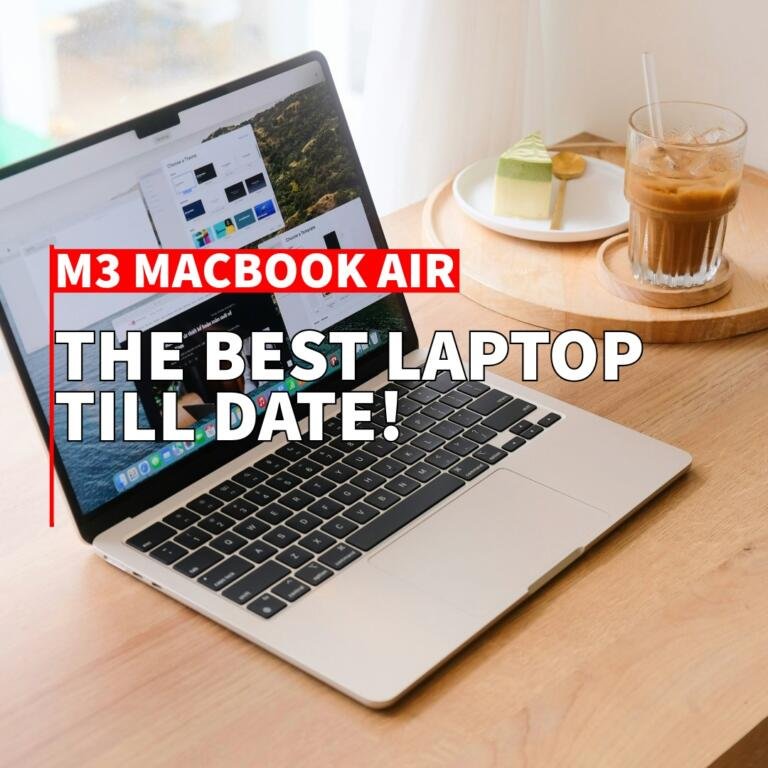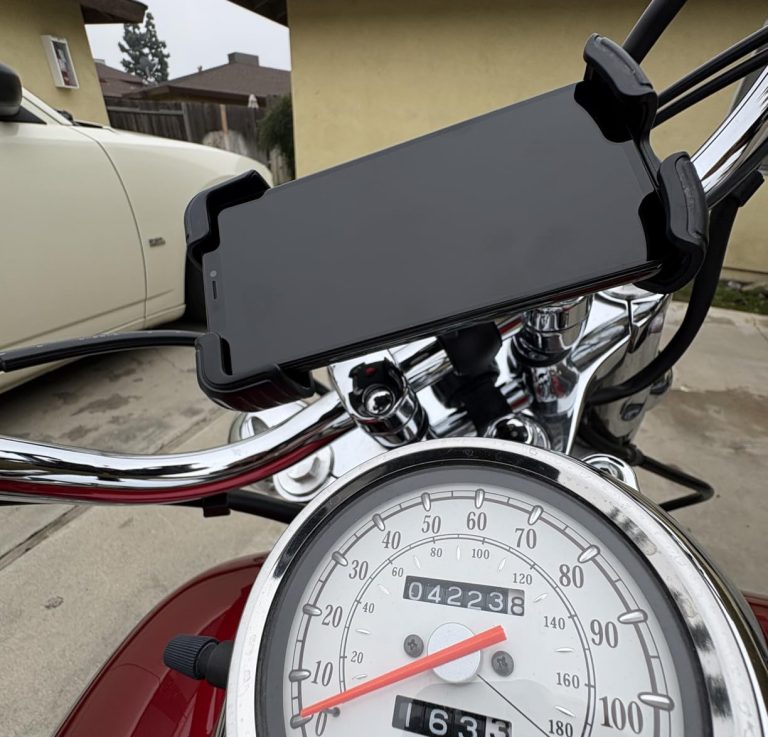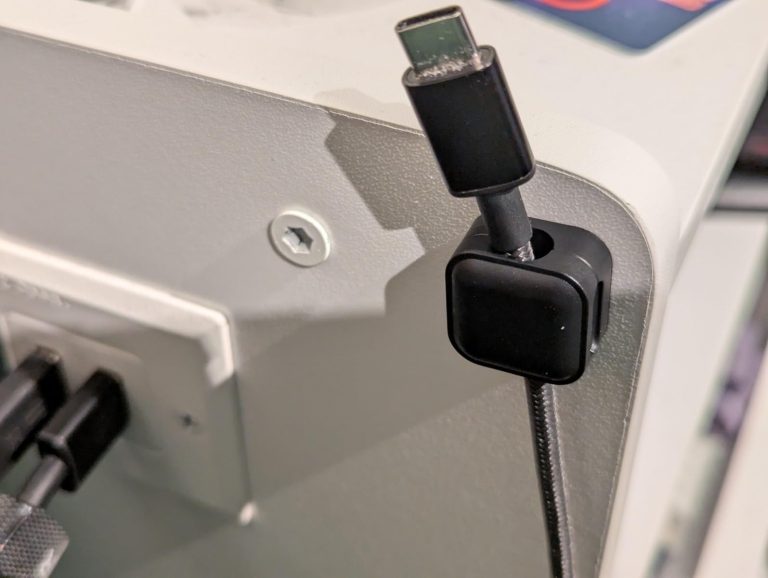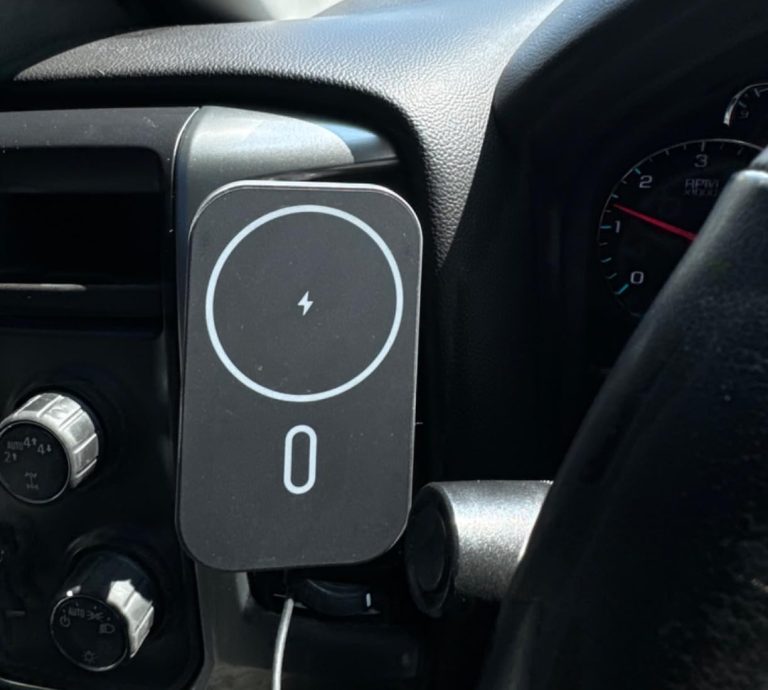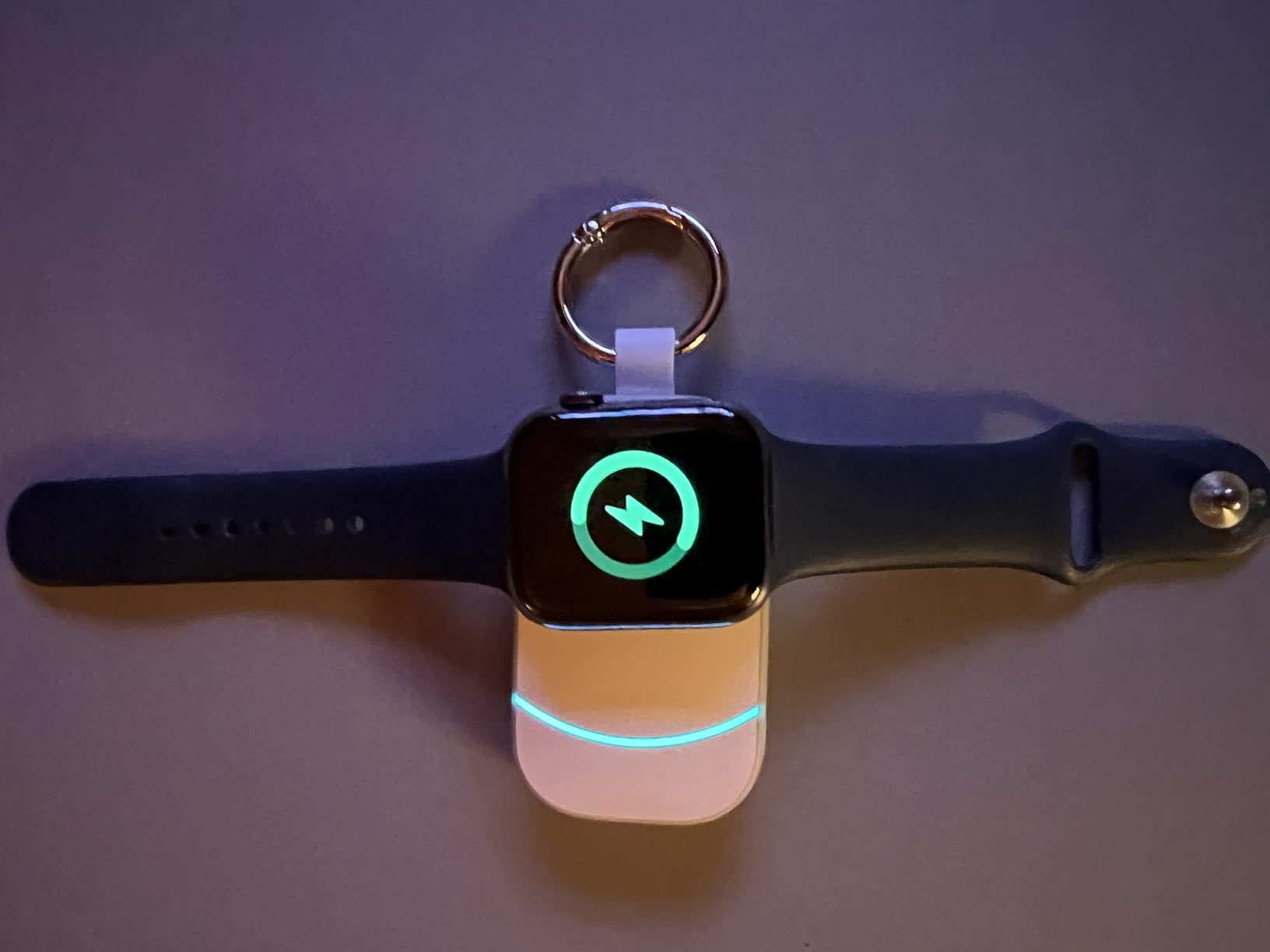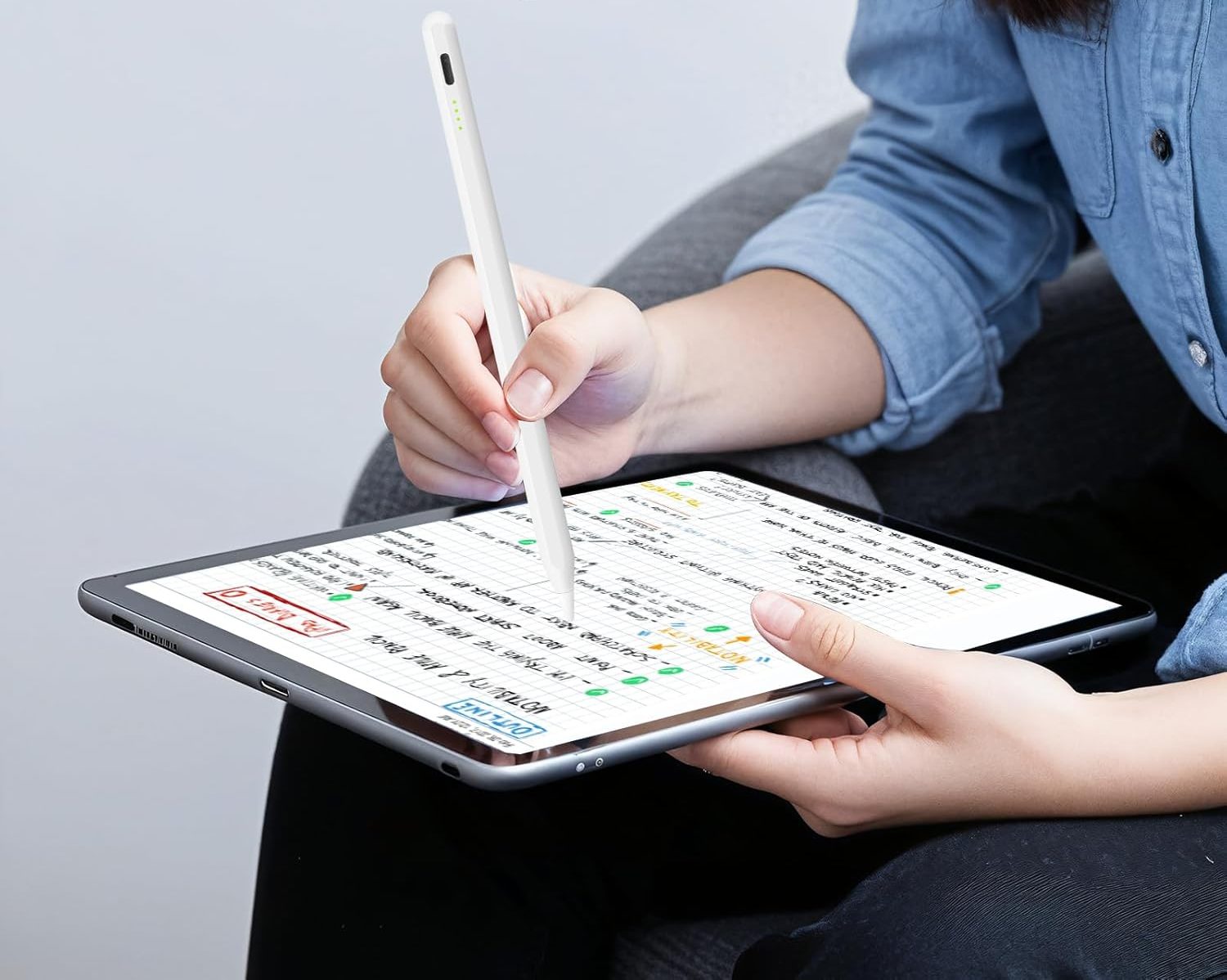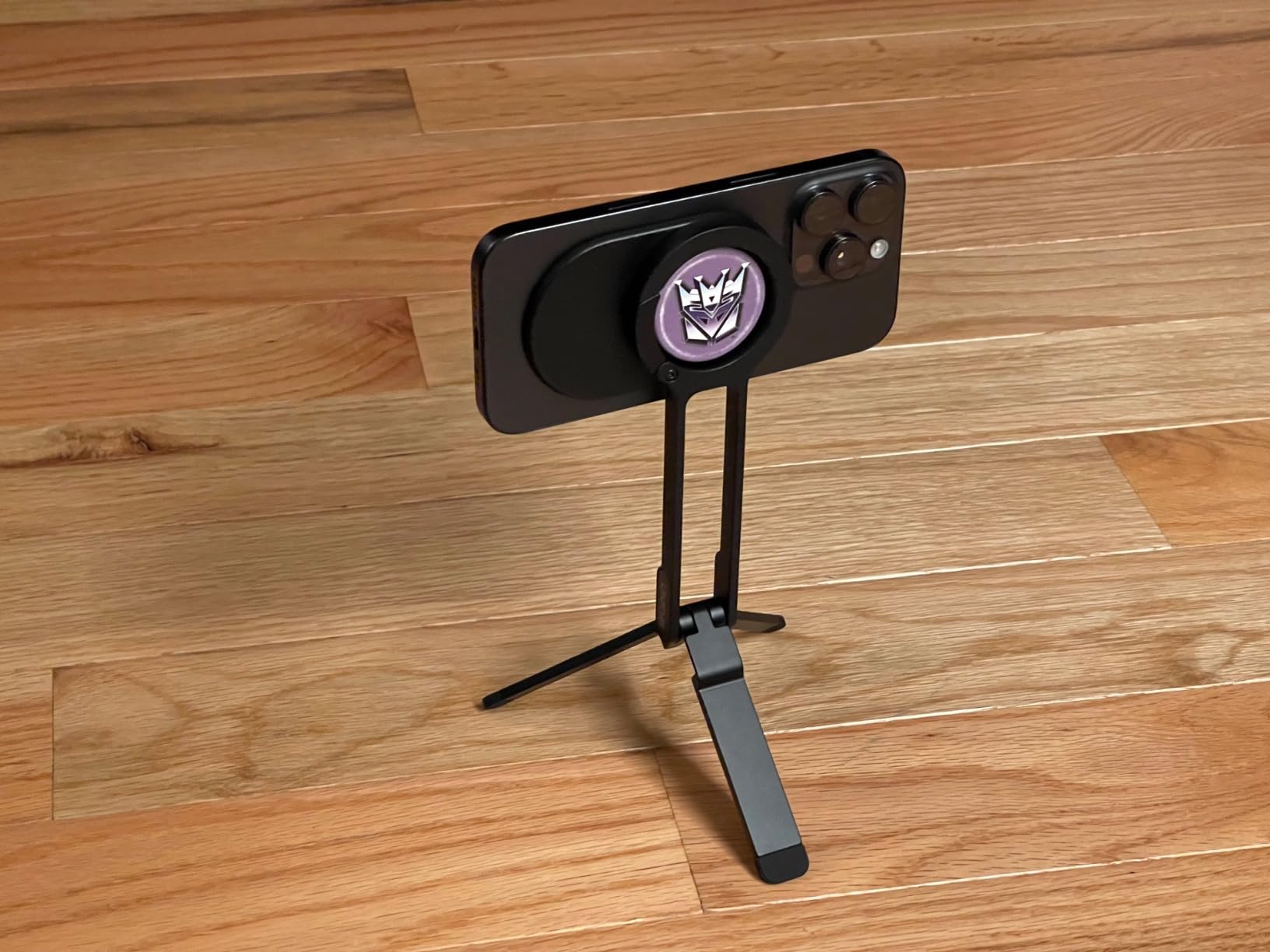NEW M3 MODEL ADDS GREATNESS TO APPLE’S BEST-SELLER LAPTOP RANGE.
We have long advocated the MacBook Air as the ideal laptop for the vast majority of people due to its affordable pricing, excellent performance, and extensive feature set. In 2022, Apple revamped it and upgraded it to the M2 chip. In 2023, they introduced a 15-inch M2 variant, making it even more appealing.The MacBook Air is the latest addition to Apple’s M3 lineup, which was launched last autumn. The only real difference between the old and new M3 MacBook Airs is the processor, but other than that, it’s essentially the same notebook. The MacBook Air is still the greatest notebook for nearly everyone, and that’s not changing much—or how we feel about it, either.
SPECIFICATIONS
The M2 chip is replaced with the M3 chip in the MacBook Air. If you’re interested in the M3 Pro or Max chips, you’ll have to check out the MacBook Pro instead. on learn more about the variations between the various M3 chips, check out our guide on the M3 chip series.
This evaluation focuses on the 15-inch MacBook Air, which is Apple’s most costly basic configuration. An increase in price is possible when more memory and a bigger SSD are added as customization options.
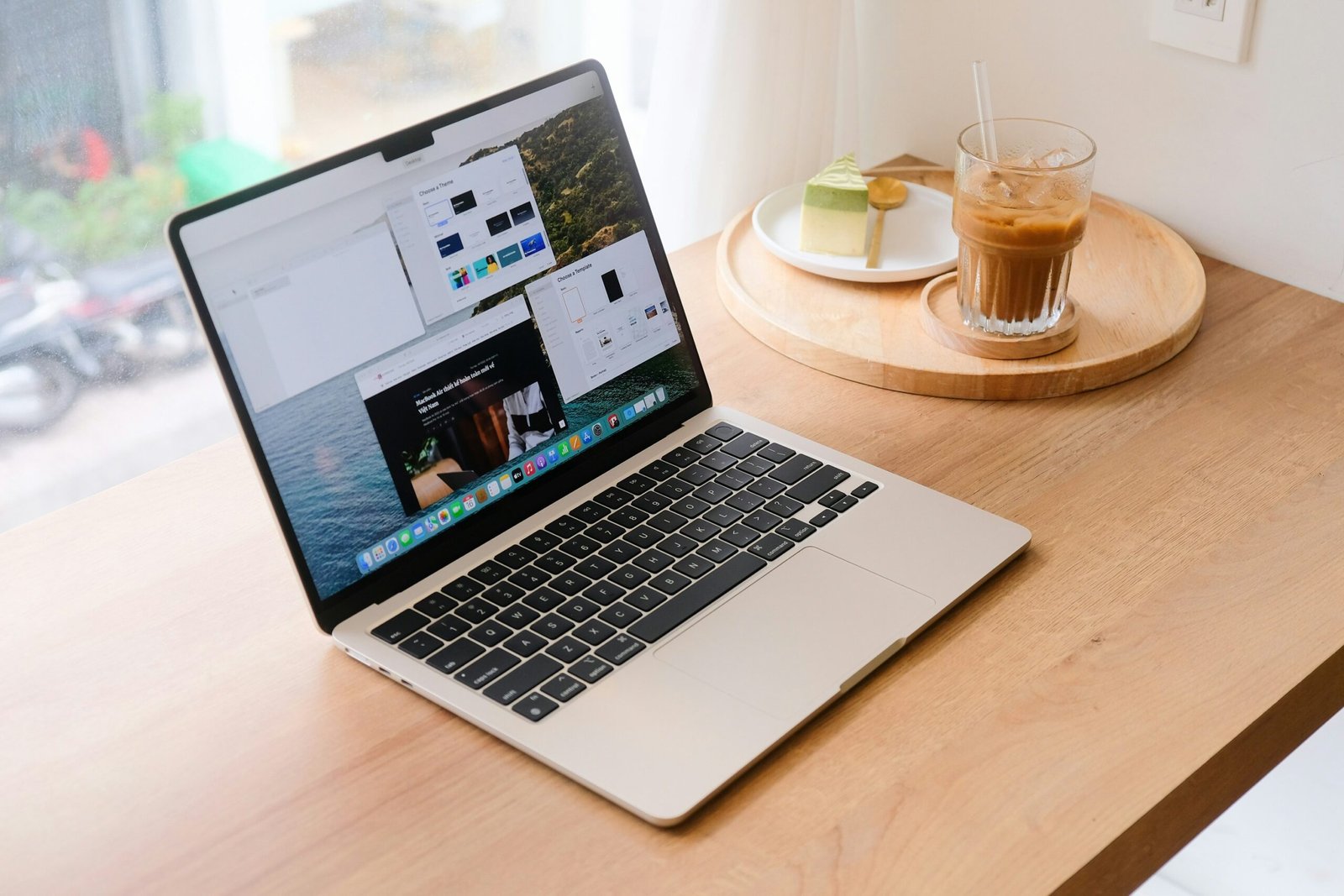
The review laptop’s specs are as follows:
Processing Unit: M3 featuring an 8-core CPU (four efficiency cores and four performance cores) and a 16-core Neural Engine
Visual processing unit: 10-core
Random Access Memory (RAM): 16 GB (100 GB/s memory bandwidth)
Volume: 512 GB solid-state drive
Display: A 15.3-inch IPS Liquid Retina LED backlit display with 224 ppi, 500 nits of brightness, P3 color, and True Tone. Connections: 2 Thunderbolt 4/USB-C, MagSafe 3, and a 3.5mm audio jack.
For connections, there is Bluetooth 5.3 and Wi-Fi 6E (802.11ax).
Mass: 3.31 lb (1.51 kg)
This item has the following dimensions: 0.45 by 13.40 by 9.35 inches (1.15 by 34.04 by 23.76 cm).
Capacity of the battery: 66.5Wh
Cost: $1,699
PERFORMANCE
With the new M3 CPU, the MacBook Air gets a speed boost, which is the main focus of this upgrade. In our tests, we compared it to the M2 before it and to other M3 Macs from Apple.
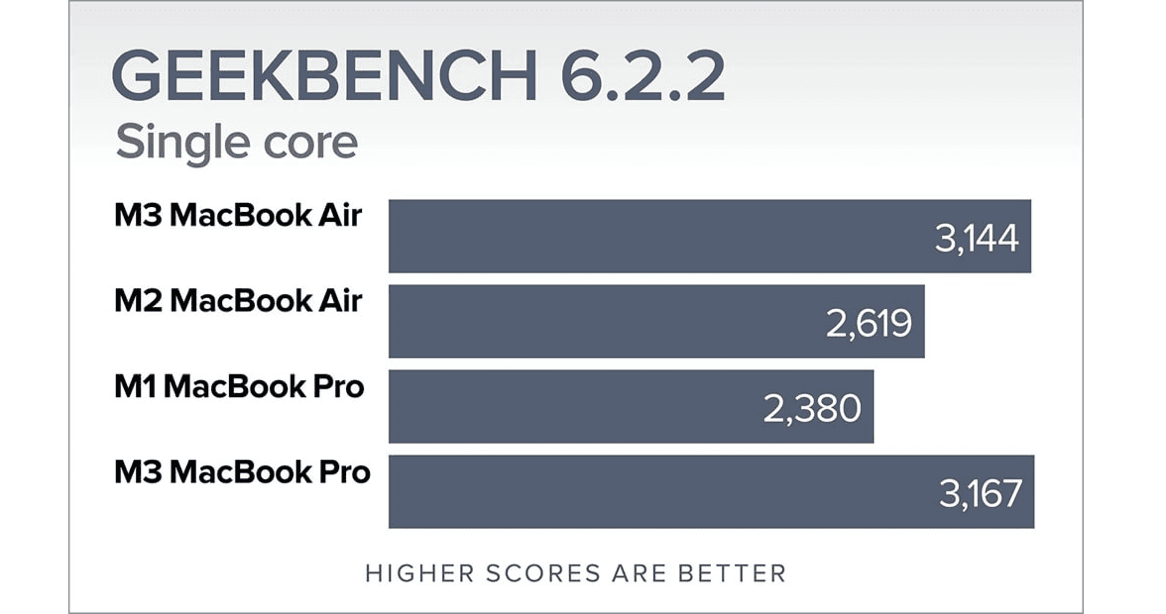

When we want to know how fast a Mac is in general, we utilize Geekbench 6. An expected improvement between generations of processors, the M3 MacBook Air outperformed the M2 in both single-core and multi-core benchmarks by 20%.
There is a clear performance gap between the M3 MacBook Air and the M3 MacBook Pro. Given that they share a chip, that is to be anticipated. A key distinction between the two is the presence or absence of fans on the MacBook Pro and Air. In order to keep the chip from overheating, the MacBook Air may slightly reduce performance when faced with demanding workloads. Since it requires a lot to get the MacBook Air to do this, most people shouldn’t be concerned.

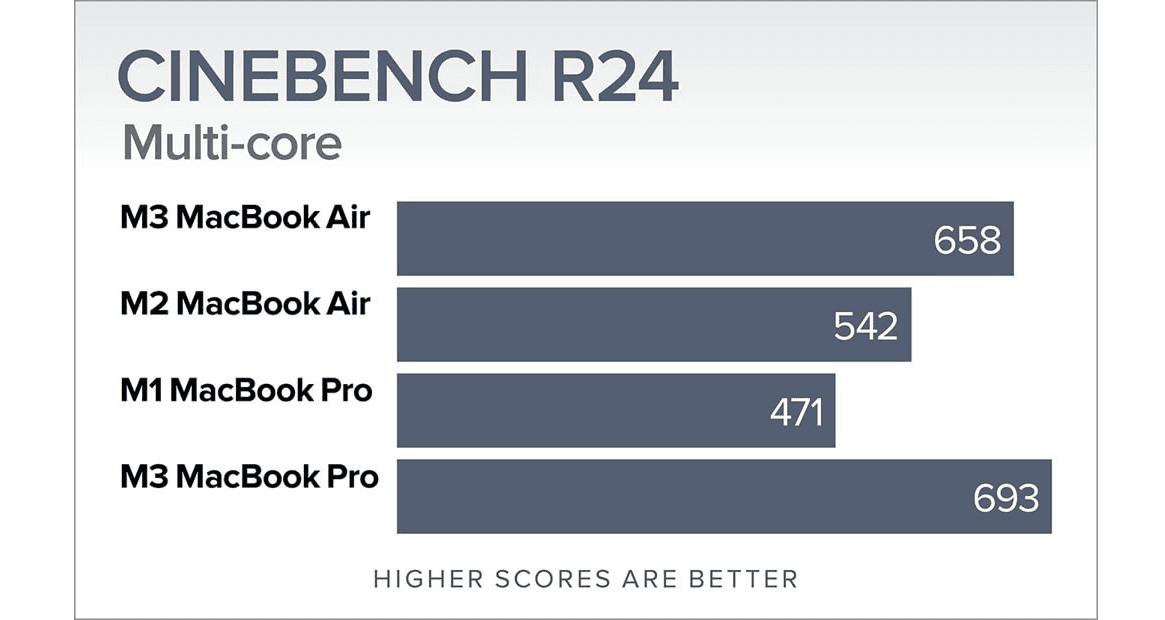
The 3D rendering test, Cinebench 2024, is responsible for the aforementioned labor-intensive operation. Those that utilize such software certainly don’t use a MacBook Air as their primary tool, but it’s still worth considering because of its performance. The M3 MacBook Air holds its own in these tests, and the benchmark provides a solid basis for comparison with comparable Macs.
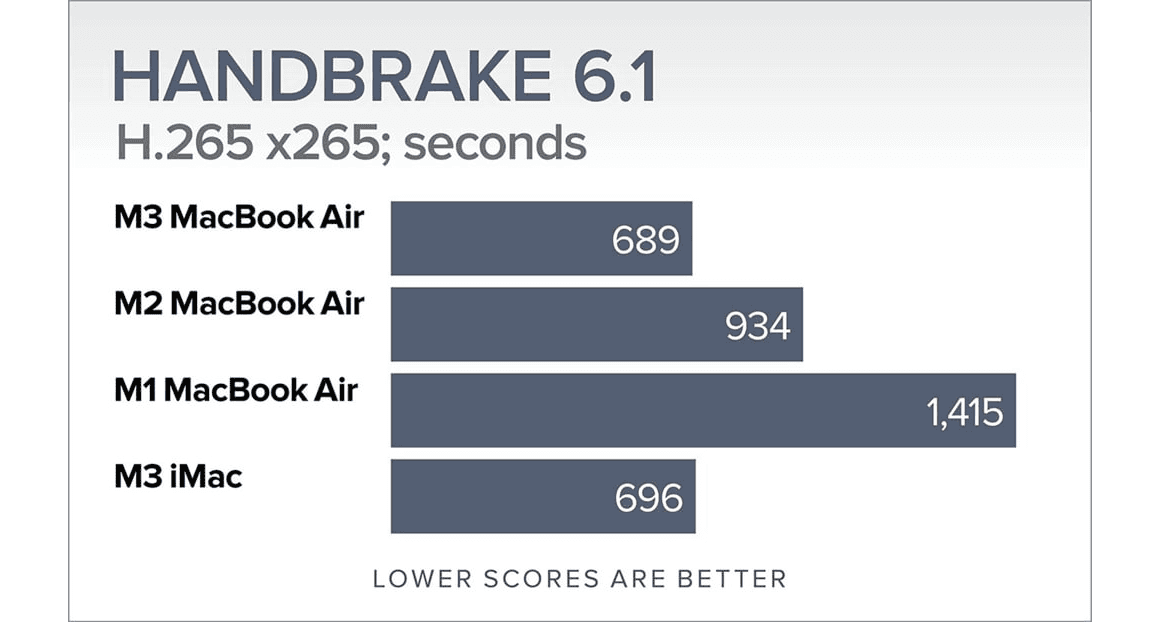

To convert the 4K version of Tears of Steel to a 1080p H.265 file, we utilized HandBrake. With the H.265 (x265) video encoder running in software, the M3 outperforms the M2 by a respectable 26 percent. Using the built-in hardware acceleration in HandBrake’s H.265 (VideoToolBox) encoder resulted in a 17% improvement for the M3.
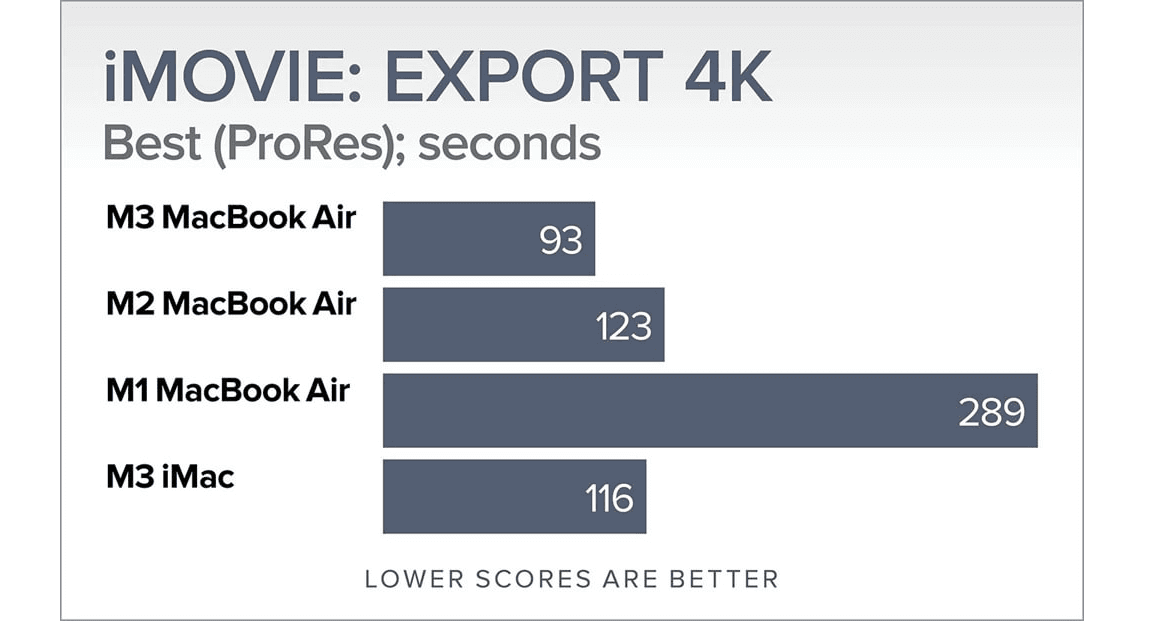
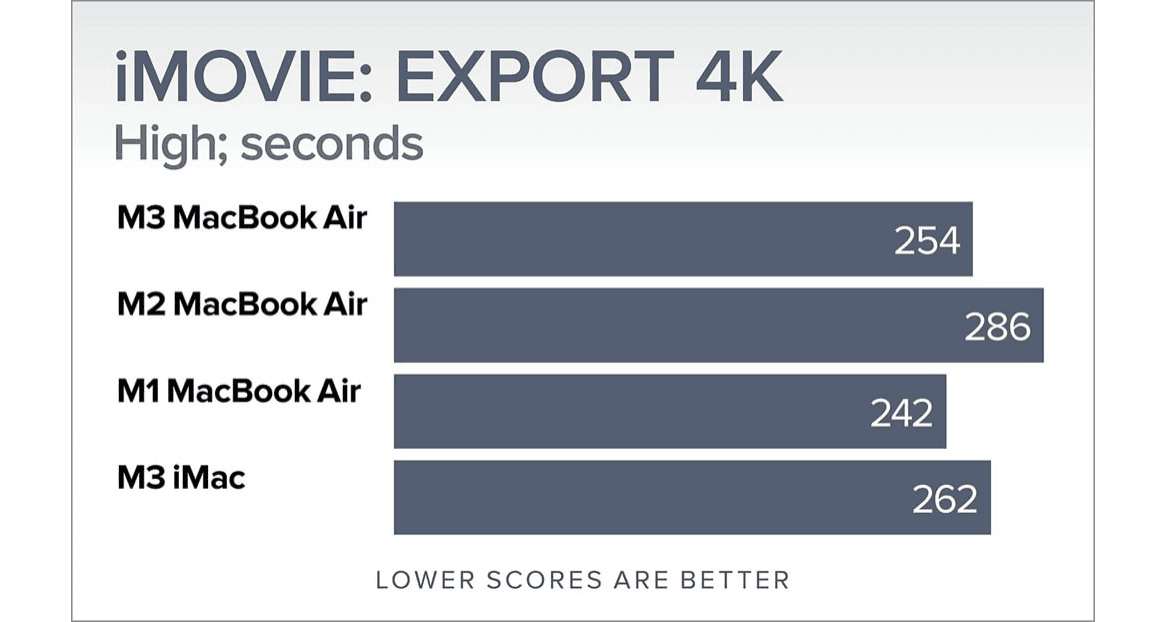
We used two different settings in iMovie to produce a 10-minute 4K film in order to measure the CPU’s performance. When using the ProRes codec for export, the M3 outperformed the M2 by a margin of 24%. The M3 advantage decreased to 11% after we raised the export quality to High.
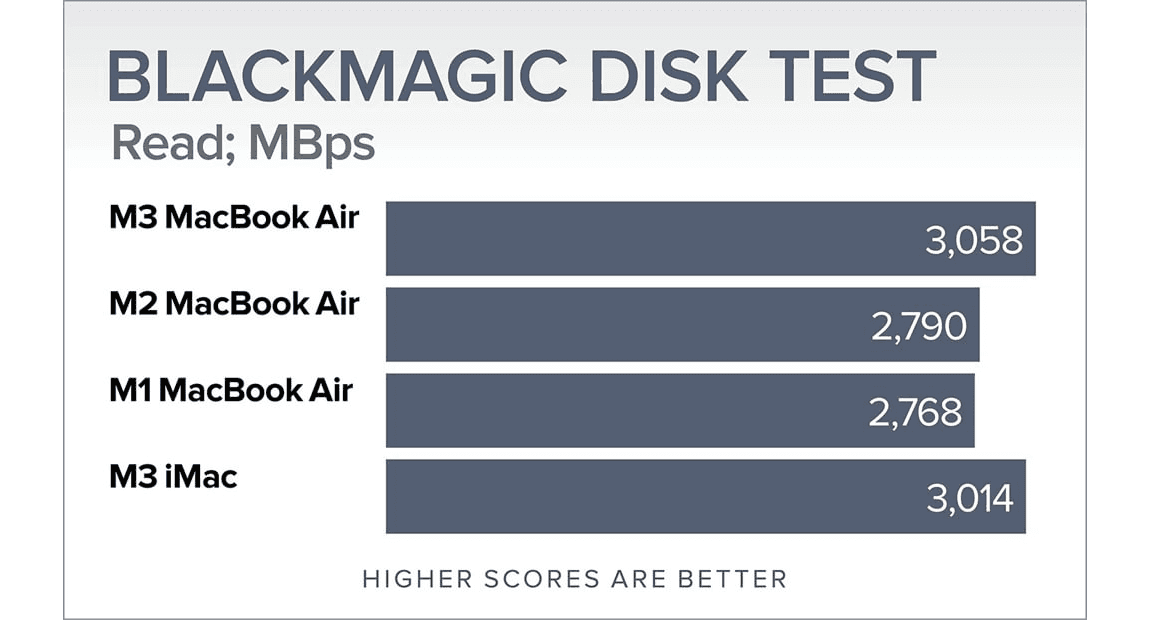
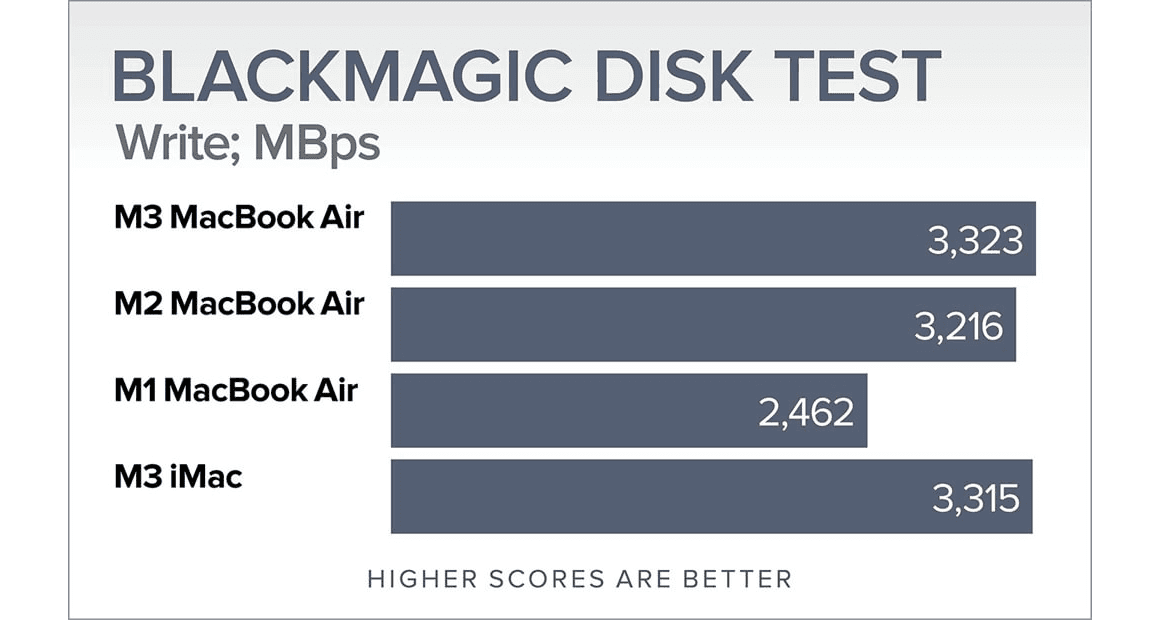
The M3 and M2 show almost identical results when we test the performance of the 512GB SSD in our review sample. The M1 MacBook Air we tested had a 256GB SSD implemented as one NAND chip, but the M3’s 512GB SSD is a combination of two NAND chips. This is an intriguing difference between the two models. As we explain in the “Price and availability” section below, having two chips is preferable than one. This is evident here.
The M1 and M2 MacBook Air only had one 256GB chip, but the M3 MacBook Air’s 256GB SSD changes all that. Max Tech claims in their disassembly that the 256GB SSD now uses two processors from Apple. The 256GB SSD in the M3 MacBook Air prevents the performance drop that would occur with a single NAND chip, which is a major boon for the consumer. Hurray!
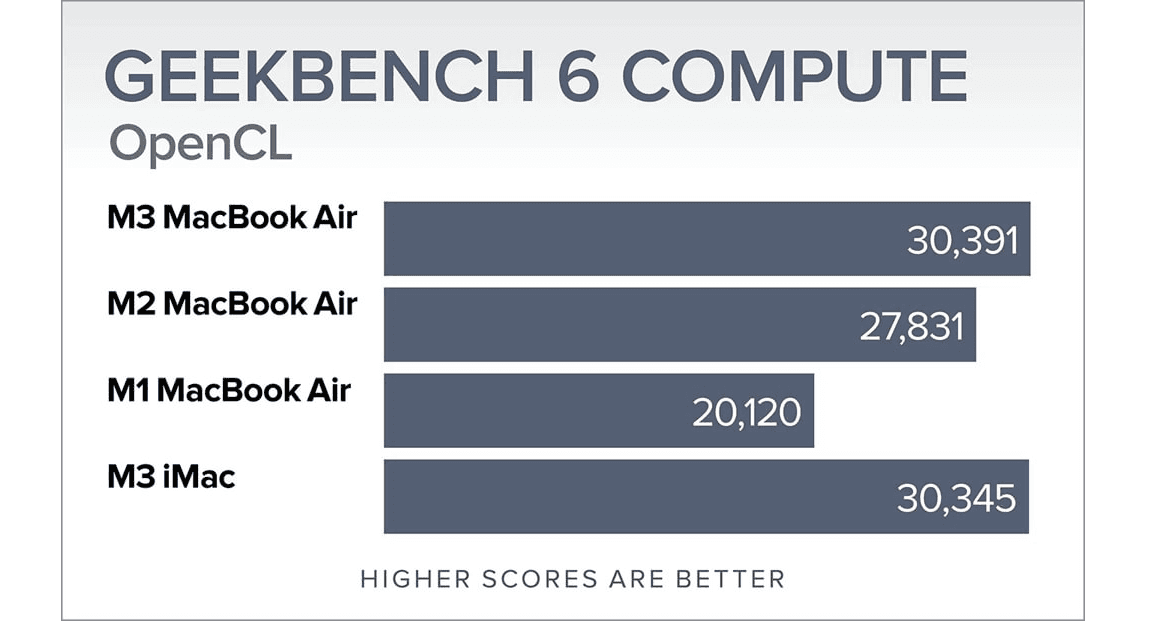
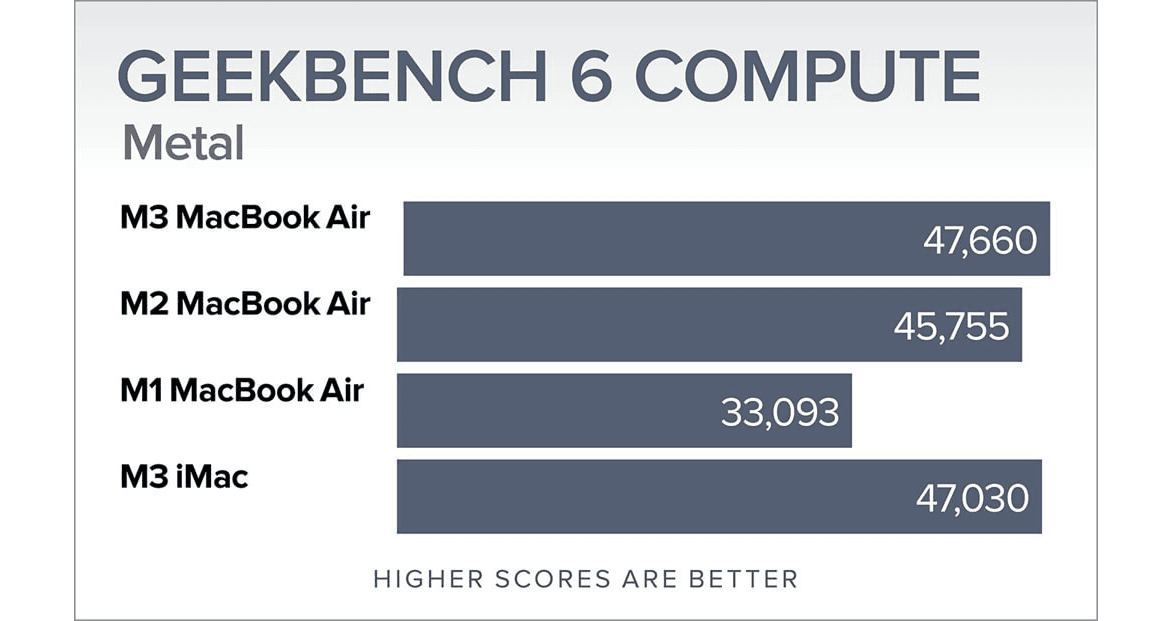
Using the Metal or OpenCL APIs, Geekbench’s Compute benchmark evaluates GPU performance. You might not even notice the M3’s little 4% improvement. We can therefore conclude that the GPU performance of the M2 and M3 MacBook Airs is same.
When compared to the M1, the M3 does offer a considerable improvement of 44%. This is just one more way in which the M3 MacBook Air excels over its predecessor, the M1.
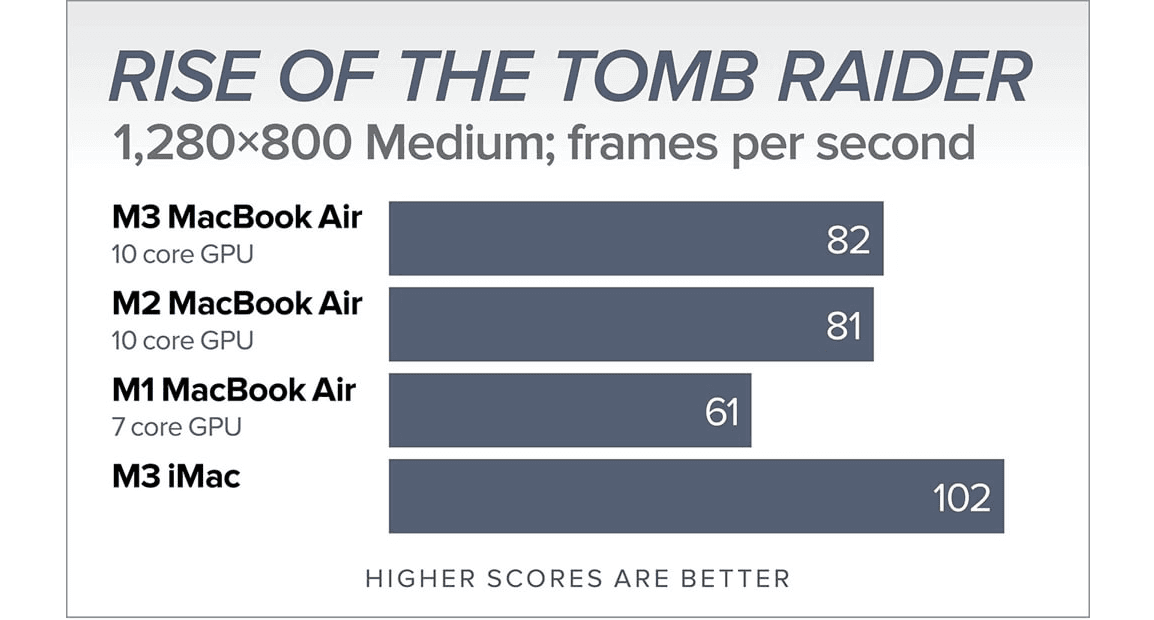
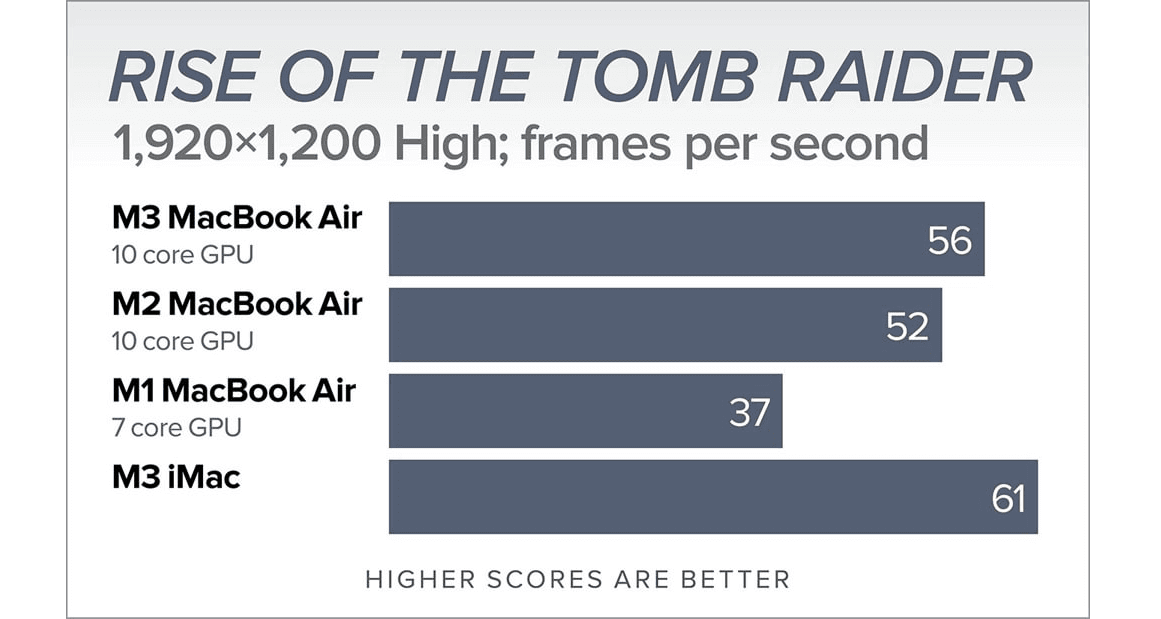
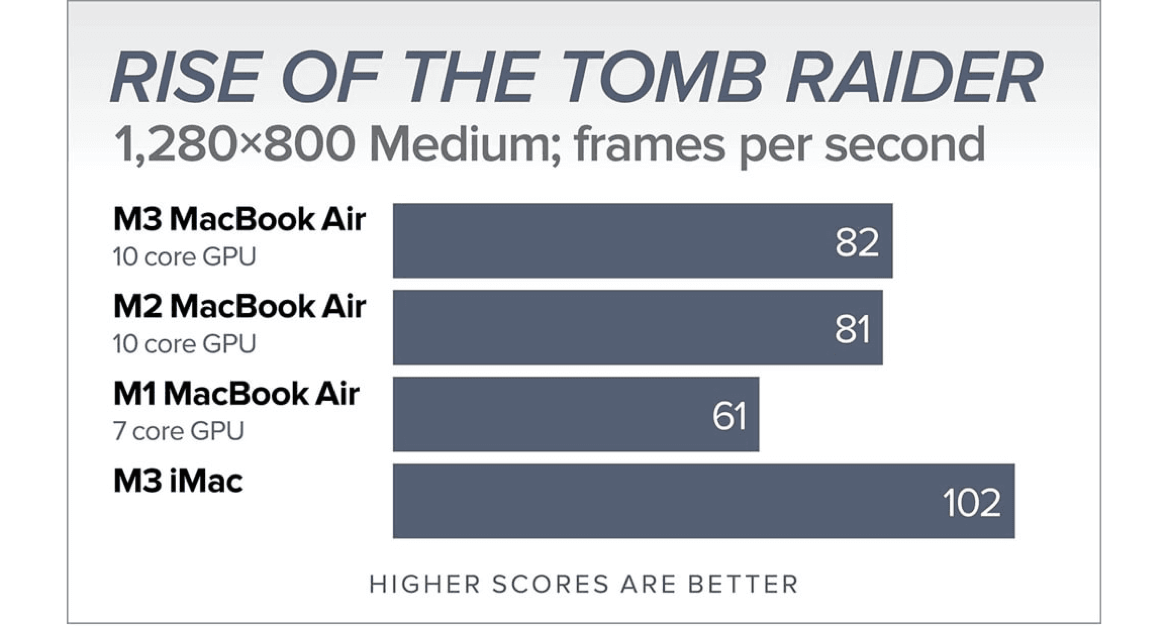
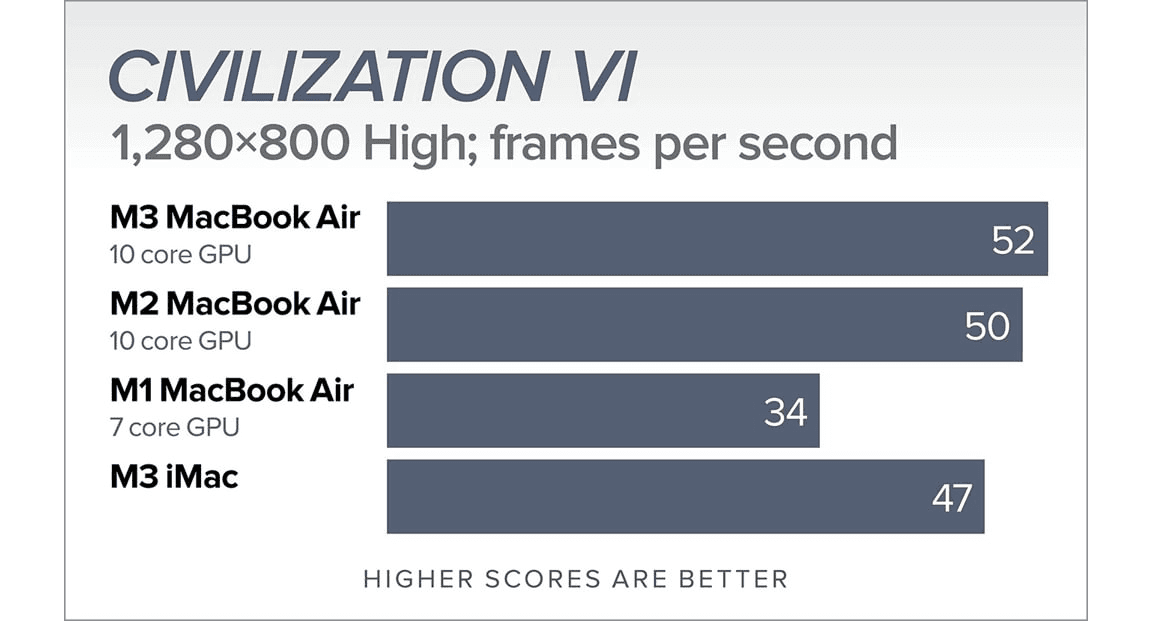
Older games developed for Intel, such as Civilization VI and Rise of the Tomb Raider, were not optimised for Apple’s Metal graphics API. Since these games aren’t making use of any existing optimizations for the Metal API, it could explain why the results for M2 and M3 are identical. But game mode for macOS is still there; it starts up automatically whenever you launch a game.
DESIGN AND BUILD
With the M2 model year of 2022, Apple debuted the current MacBook Air design. At first sight, you might not be able to distinguish it from the MacBook Pro, despite the fact that its design is not an exact replica of the latter. Maybe you’ve become very familiar with the hues of the MacBooks from your frequent visits to the Apple Store and can tell them apart at a glance. However, the design language is identical across all MacBooks.
And it’s true: Apple “translated” a Space Black MacBook Pro function into the Midnight MacBook Air color choice. The “breakthrough anodization seal” that Apple claims eliminates fingerprints is now on that model. I wasn’t able to test the seal on the Starlight model because it isn’t a Midnight review, but I did test it on a Space Black MacBook Pro, and the seal is effective; it doesn’t stop fingerprints entirely, but they aren’t visible and can be easily removed. It contributes to keeping Apple’s design style consistent.
The MacBook Air comes in a variety of colors, including Silver, Space Gray, Midnight, and Starlight. In comparison to the MacBook Pro, which only comes in two color options, this one has four.
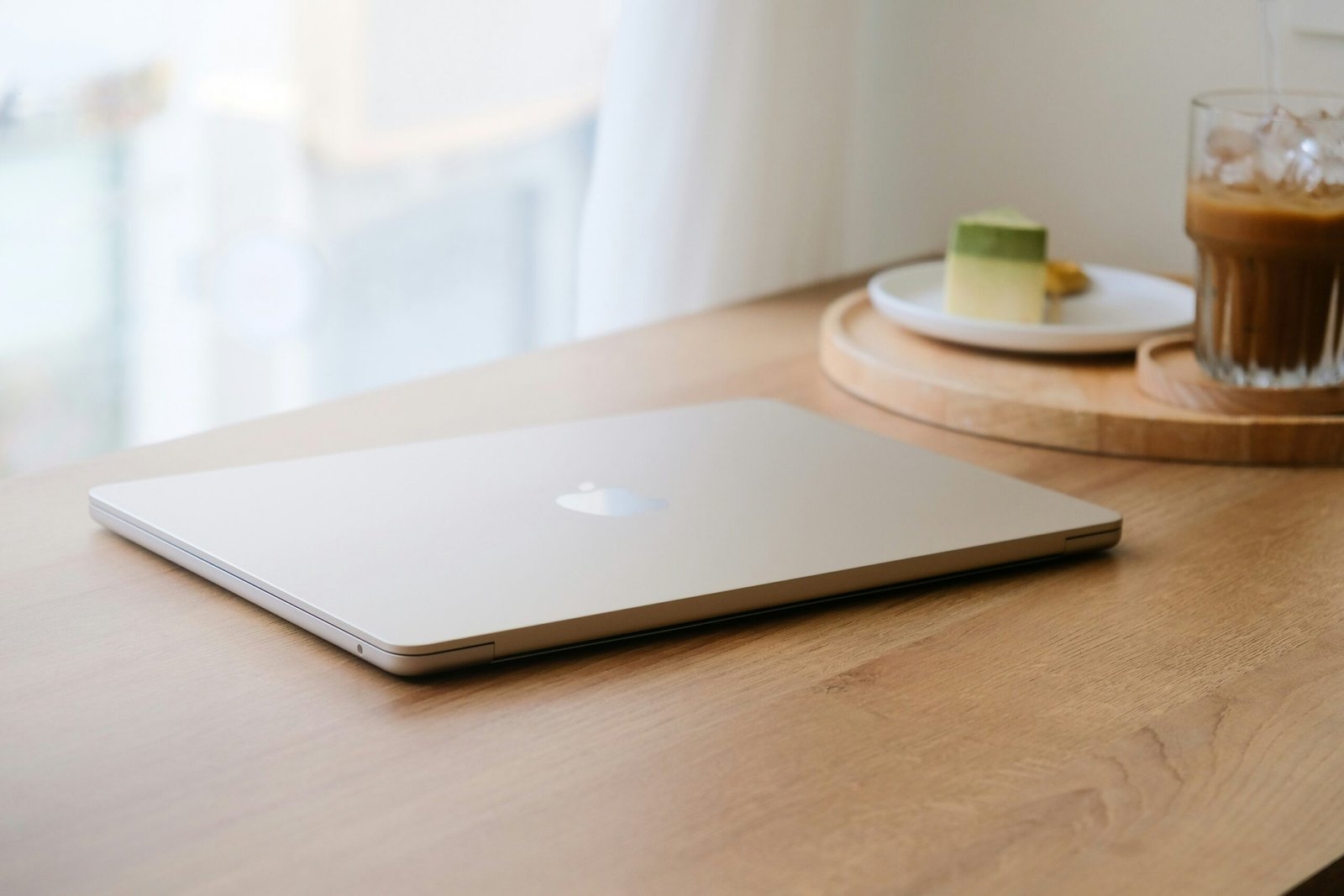
In general, it has the well-planned, long-lasting, and fashionable design and build that Apple is known for. But what made the MacBook Air famous and popular among Air users wasn’t its distinctive wedge design. The last wedge-shaped Air, the M1 MacBook Air, is available in the Apple Certified Refurbished Store or through third-party vendors with residual stock if that’s absolutely what you desire.
PORTS AND CONNECTIVITY
On the MacBook Air, you can find a 3.5mm headphone jack, two Thunderbolt 4/USB-C connectors, and a MagSafe 3 charging port. It’s done. In contrast to the MacBook Pro, which combines portability with desktop Mac sensibilities, Apple presents the Air as a laptop that places an emphasis on mobility. Aircraft will have fewer ports as a result.
If you’re thinking, “But I need to connect more than two devices,” then a USB-C hub would be a good investment. For assistance in locating one, please refer to our article on USB-C hubs and adapters. You should contact the maker of the hub to find out what its capabilities are, as there may be restrictions on the number of devices you can connect or even the kinds of devices (such as external monitors) you can use.
The other new feature stated at the beginning of this review comes to mind when we talk about external screens. Two external 5K monitors, each with a 60Hz refresh rate, are now compatible with the M3 MacBook Air. But you can’t accomplish this unless you close the Air. The video signal from one of the external monitors will be diverted to the laptop display when you open the laptop while both displays are connected. The functionality of the M3 MacBook Pro’s two external monitors is detailed in a different article.
This appears to be a benefit at first glance; however, due to the closed laptop design, the Air’s keyboard and trackpad cannot be utilized. As a result, an external keyboard, mouse, and/or trackpad must be attached. If you’re not satisfied with this tradeoff, your sole choice is to purchase a MacBook Pro M3 Pro or M3 Max, which can accommodate extra displays when the laptop is opened. For a fraction of the price of the M3 Pro and Max, you could acquire a used MacBook Pro, namely an M2 Pro or M2 Max. Find out more information regarding the MacBooks’ compatibility with external displays.
Bluetooth 5.3 and Wi-Fi 6E (802.11ax), an update from Wi-Fi 6 (802.11ax) in the M2 MacBook Air, make up the third new feature of the MacBook Air that pertains to wireless communication. A little quicker networking speed is usually an improvement.
DISPLAY AND SPEAKERS
The MacBook Air’s Liquid Retina (LED) screens are an improvement over the MacBook Pro’s Liquid Retina XDR (mini-LED) screens. For regular use, though, the MacBook Air’s screen is perfectly fine, thus no one ever finds it unappealing.

A set of six speakers, including force-cancelling woofers, is equipped with the 15-inch MacBook Air. (There are four speakers in the 13-inch Air.) Compared to the 14-inch MacBook Pro, which features a high-fidelity six-speaker system with woofers, this setup is drastically different. Although the Air’s speakers aren’t as crisp as the Pro’s, they nonetheless produce respectable audio and pack a respectable punch for such a slender laptop. Dolby Atmos also supports spatial audio in media. You can use headphones with a high impedance with the 3.5mm audio connector.
CAMERA
I’ve looked at a lot of MacBooks in the M-series, and the majority of them share the same 1080p FaceTime camera. The following are my thoughts on the camera of the M3 MacBook Air, since it is identical to the previous model: The 720p camera that Apple utilized for a long time is much superior, and while it’s fine, it has the potential to be much better.
During a videoconference, the camera’s picture quality is unlikely to make you feel self-conscious. You should look for something else if you plan on using it to capture footage of yourself. In your pocket, on your iPhone, is that superior camera. The Continuity Camera feature in macOS allows the iPhone to connect to the laptop and function as a webcam.
BATTERY LIFE AND CHARGING
The M3 MacBook Air’s battery remains unchanged from its predecessor, meaning it maintains its claimed rating of up to 18 hours of video playback time. The video plays continuously until the battery dies, with the brightness level set to 150 nits, as part of our battery test. With a battery life of approximately 19 hours, the M3 Air was nearly on par with the M2 MacBook Air. The battery life of the Air is expected to last all day without needing to be plugged in, according to Apple’s repeated claims.
You may charge your MacBook Air and any other device you plug it into using the 35W power adapter that Apple provides, which has two USB-C ports. The braided MagSafe cable that comes with the iPhone from Apple is far more sturdy than the previous rubberized versions.
KEYBOARD AND TRACKPAD
The trackpad and keyboard on the M3 MacBook Air are identical to those on the M2 Air. A Touch ID button is in the top right corner of the illuminated keyboard, which also features full-size Function keys. The trackpad is second to none, and the keyboard is adequate.
PRICE AND AVAILABILITY
Similar to its M2 forerunner, the M3 MacBook Air maintains the same price point. There’s a small change: the $1,699 Air reviewed here is now available in three standard configurations, and the only one with 16GB of RAM. Both the $1,299 and $1,499 models of the 15-inch M2 MacBook Air came with 8GB of RAM as standard; upgrading the $1,499 model to 16GB of RAM would have increased the price to $1,699. Because it is a common setup, you may expect to see it on sale at Amazon in the near future.
In fact, we advise going with a MacBook Pro, a 13-or 15-inch MacBook Air, or any model with 16 GB of RAM. Our recommendation is that you upgrade the 8GB RAM in the standard configuration to 16GB if possible. Considering how much RAM modules cost nowadays, the $200 increase from 8GB to 16GB is quite expensive. Users are unable to install additional RAM into a Mac after purchase, therefore you’ll have to pay for it.
VERDICT
If you value portability above all else, the MacBook Air is the notebook for you. Whether you need to multitask with a word processor and a million Safari tabs open, use iMovie and GarageBand for something a little more involved, or work at a professional level with a video production tool or software development, it can manage it all, thanks to Apple silicon.
I highly recommend the M-Series laptops to anyone who is still using an Intel MacBook. The performance of the M3 MacBook Air is so amazing that you will adore it—and maybe even be mad at yourself for waiting so long to get it. I understand that some people rely on Intel for very necessary products, but if you can discover an option that works with M-series, try to incorporate it. The latest M-series model, which is the third iteration, is dependable, functional, and steady.
The M3’s support for two external displays is the sole compelling feature to consider upgrading from an M2 MacBook Air. A 20% performance bump is great (more speed is always better), but it won’t make much of a difference when you’re doing regular things. Go ahead and shell out the cash if you’re always in need of more speed.
More considerations arise for users of M1 MacBook Airs. Aside from the noticeable improvement in performance between the M1 and M3, there is also the noticeable shift in design that was introduced with the M2 MacBook Air. Despite having a larger screen, the new laptop has a somewhat larger profile than its predecessor. Keeping the M1 Air is reasonable because it is still a solid laptop, but upgrading is still an option.
We highly suggest obtaining a minimum of 16GB of unified memory if you do decide to get the M3 MacBook Air, regardless of your condition. As the amount of RAM increases, the laptop’s reliance on the SSD for memory swapping decreases, leading to improved performance. The additional expense of at least $1,299 is unfortunate, but it will be worthwhile in the long run.
"Note:We may receive a affiliate commission when you purchase products mentioned on our website."

